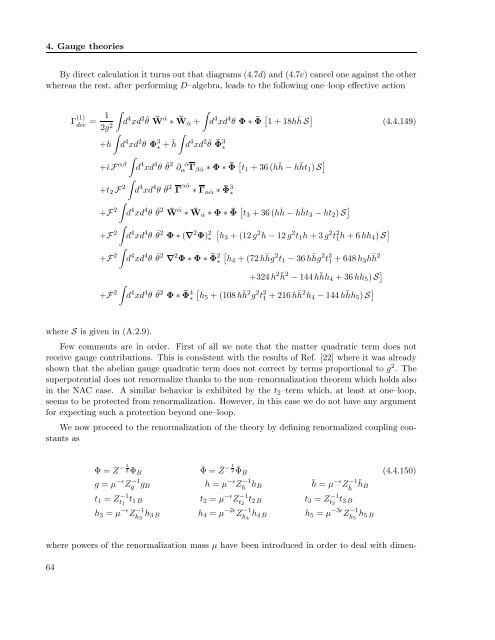Perturbative and non-perturbative infrared behavior of ...
Perturbative and non-perturbative infrared behavior of ...
Perturbative and non-perturbative infrared behavior of ...
Create successful ePaper yourself
Turn your PDF publications into a flip-book with our unique Google optimized e-Paper software.
4. Gauge theories<br />
By direct calculation it turns out that diagrams (4.7d) <strong>and</strong> (4.7e) cancel one against the other<br />
whereas the rest, after performing D–algebra, leads to the following one–loop effective action<br />
Γ (1)<br />
div<br />
1<br />
=<br />
2g2 <br />
d 4 xd 2¯ θ ¯W ˙α <br />
∗ ¯W ˙α + d 4 xd 4 θ Φ ∗ ¯Φ 1 + 18h¯ h S <br />
(4.4.149)<br />
<br />
+h d 4 xd 2 θ Φ 3 ∗ + ¯ <br />
h d 4 xd 2¯ θ ¯Φ 3 ∗<br />
+i F αβ<br />
<br />
d 4 xd 4 θ ¯ θ 2 ∂ ˙α<br />
α Γβ ˙α ∗ Φ ∗ ¯Φ t1 + 36(h¯ h − h¯ ht1) S <br />
+t2 F 2<br />
<br />
d 4 xd 4 θ ¯ θ 2 Γ α ˙α ∗ Γα ˙α ∗ ¯Φ 3 ∗<br />
+F 2<br />
<br />
d 4 xd 4 θ ¯ θ 2 ¯W ˙α ∗ ¯W ˙α ∗ Φ ∗ ¯Φ t3 + 36(h¯ h − h¯ ht3 − ht2) S <br />
+F 2<br />
<br />
d 4 xd 4 θ ¯ θ 2 Φ ∗ (∇ 2 Φ) 2 <br />
∗ h3 + (12g 2 h − 12g 2 t1h + 3g 2 t 2 1h + 6hh4) S <br />
+F 2<br />
<br />
<br />
h4 + (72h¯ hg 2 t1 − 36h¯ hg 2 t 2 1 + 648h3h¯ h 2<br />
d 4 xd 4 θ ¯ θ 2 ∇ 2 Φ ∗ Φ ∗ ¯Φ 2 ∗<br />
+324h 2¯2 h − 144hhh4 ¯ + 36hh5) S <br />
+F 2<br />
<br />
d 4 xd 4 θ ¯ θ 2 Φ ∗ ¯Φ 4 <br />
∗ h5 + (108h¯ h 2 g 2 t 2 1 + 216h¯ h 2 h4 − 144h¯ hh5) S <br />
where S is given in (A.2.9).<br />
Few comments are in order. First <strong>of</strong> all we note that the matter quadratic term does not<br />
receive gauge contributions. This is consistent with the results <strong>of</strong> Ref. [22] where it was already<br />
shown that the abelian gauge quadratic term does not correct by terms proportional to g 2 . The<br />
superpotential does not renormalize thanks to the <strong>non</strong>–renormalization theorem which holds also<br />
in the NAC case. A similar <strong>behavior</strong> is exhibited by the t2–term which, at least at one–loop,<br />
seems to be protected from renormalization. However, in this case we do not have any argument<br />
for expecting such a protection beyond one–loop.<br />
We now proceed to the renormalization <strong>of</strong> the theory by defining renormalized coupling constants<br />
as<br />
Φ = Z −1<br />
2ΦB<br />
¯Φ = ¯ Z −1<br />
2 ¯ ΦB<br />
g = µ −ǫ Z −1<br />
g gB h = µ −ǫ Z −1<br />
h hB<br />
t1 = Z −1<br />
t1 t1 B<br />
h3 = µ −ǫ Z −1<br />
h3 h3 B<br />
t2 = µ −ǫ Z −1<br />
t2 t2 B<br />
h4 = µ −2ǫ Z −1<br />
h4 h4 B<br />
¯h = µ −ǫ Z −1<br />
¯h ¯ hB<br />
t3 = Z −1<br />
t3 t3 B<br />
h5 = µ −3ǫ Z −1<br />
h5 h5 B<br />
(4.4.150)<br />
where powers <strong>of</strong> the renormalization mass µ have been introduced in order to deal with dimen-<br />
64
















